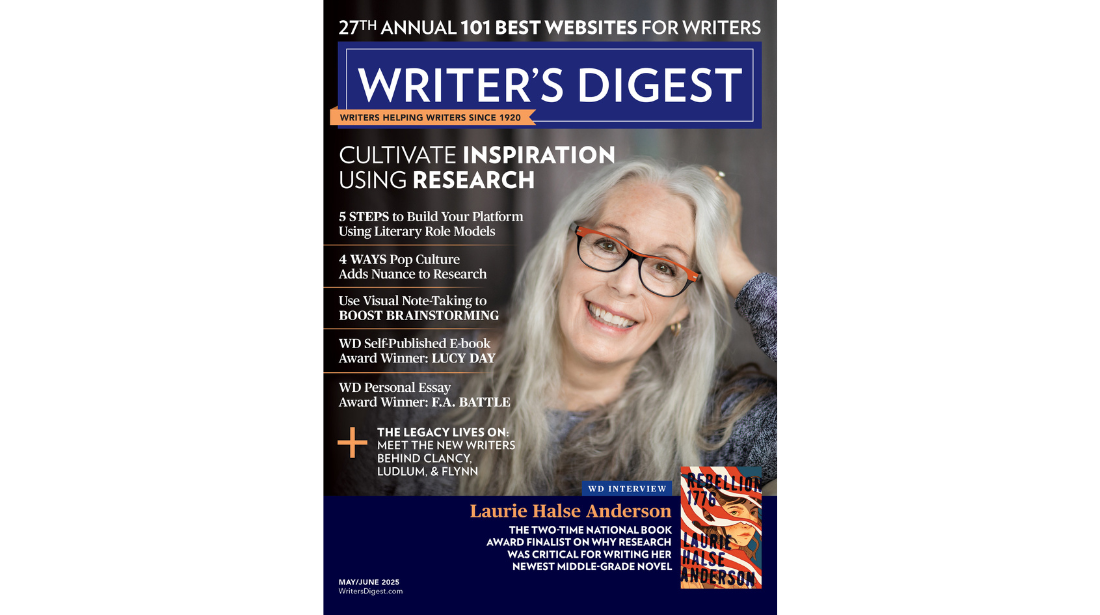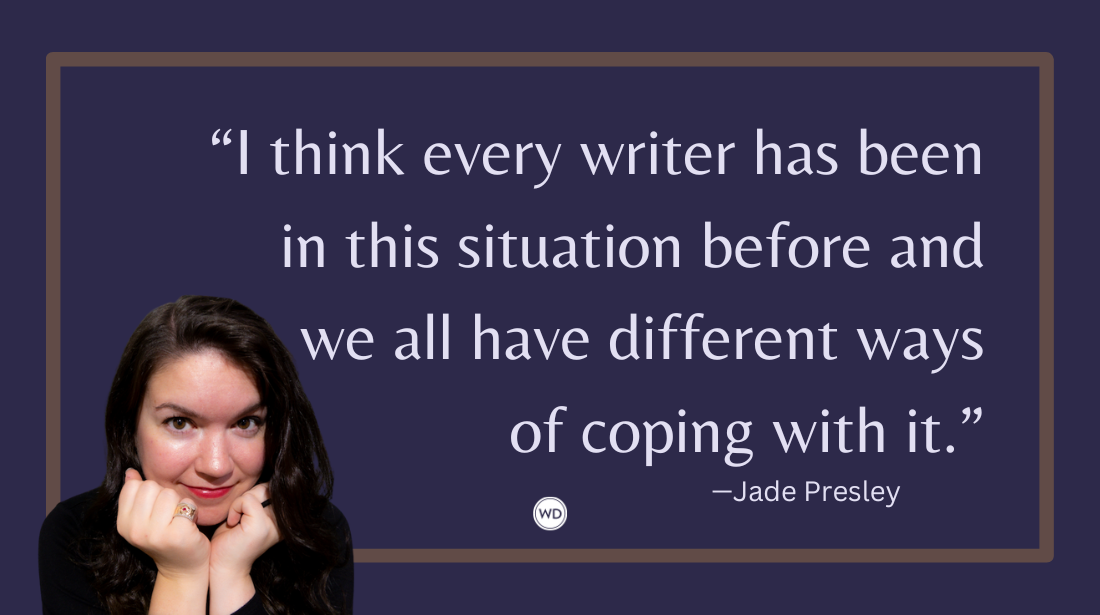How to Harness Creativity to Empower Your Writing
Learn how to tap into raw emotions and real experiences to bring strength and creativity to everything you write.
Whether writing about past trauma, significant life events or empty-nest syndrome, we as writers feel compelled to put our experiences eloquently into words and share our stories with the world. And creativity is our wellspring, the spark that ignites our writing.
Although creativity can be defined, we can’t tangibly point to it or locate it within ourselves. Still, we know it’s there. But if creativity is elusive, how do we harness it to transform our words into publishable works that hook, touch, move, elevate and even empower our readers?
Simply put, our stories must resonate with readers. We must shift our focus from ourselves to write with an awareness of others; we must make the choice to move (on the page) from having a monologue to engaging in a dialogue with our audience.
This post is by Tracy Strauss (tracystrauss.com), who has published narrative nonfiction and essays in Poets & Writers, The Huffington Post, Salon, Cognoscenti and The Southampton Review, among other publications. Winner of the Barbara Deming Memorial Fund Award for her as-yet-unpublished memoir, Strauss is currently working on a novel, teaches writing in Boston, and is an instructor for Writer’s Digest University.
“Creativity is acknowledging the possibilities,” says Amy Sue Nathan, writing coach, editor and author of The Glass Wives. Possibilities carry choices: We have the power to direct our writing whichever way we decide. So, how can we utilize our creative drive in a way that brings our writing to its fullest potential, and, ultimately, to successful publication?
Writing for Readers
The seeds of our stories are planted within ourselves. We might jot down ideas in a journal or pour our hearts out on the page of a first draft in a highly personal and uncensored manner. We formulate our innermost thoughts and then record our experiences, or sketch fictional characters and plots. We reach down deep within ourselves and see what germinates. This can be healing.
Many of us are drawn to writing for its healing power, but there is a difference between writing for therapy and writing for publication. “I used to believe that writing was too hard to be cathartic, that if it was therapeutic you were doing it wrong,” says bestselling novelist and memoirist Darin Strauss. “Now, I don’t know. My memoir [Half a Life] was, for me, very helpful. But that can’t be the reason to write one—not if you want to publish the thing. If you want to write for the express purpose of making yourself feel better—which can be valid or even noble—then [utilize] a journal.”
If the aim is to publish, then at some point in the writing process we must make a purposeful shift: We decide to share with others what has materialized on the page. Our creativity then moves from a state of self-orientation to a mode of interaction. Whatever the motivation, we transition from “navel-gazing” to an active conjoining with others through the art of writing. Our stories are the same, but our approach to telling them embraces a different dynamic and forum.
“There are many reasons to write,” says Jennifer Zobair, author of Painted Hands. “Our goal might be to entertain or inspire or foster understanding. We want to be proud of that story, we want it to be meaningful to ourselves, but I think we are always creating with the silent plea: I hope this matters to a reader.”
A short story, novel or memoir can have a profound effect on both the writer and reader. While telling our stories can be cathartic, whether or not writing makes you feel better must be secondary. “You are writing only for a reader,” Strauss says.
To do this, we must metaphorically put on a reader’s “glasses.” In this way, we gain perspective and see better how to clarify our work and how to make what we’re saying more accessible. We must transform our raw material into something that better serves others. By taking our specific circumstances and tapping into universal themes, we create a more relatable story. And in doing so, our story transcends our individual selves and becomes meaningful to others.
Empowering Characters
“Like many writers, there are both wounds and triumphs I’ve experienced that I want to explore in my work,” Zobair says. “As a novelist, I don’t write about the ways I’ve personally navigated a challenging situation; instead, I imagine a situation that might result in a familiar wound or pose a similar challenge. I create unique characters who possess both flaws and pockets of inner strength and beauty, and place them into that situation. For the story to have integrity, the characters must be permitted to have their own reactions to the circumstances. My characters and I can explore it together, but the creative part is making the narrative the characters’ story instead of my own.”
Characters function as a conduit between readers and writers: The way we approach our characters on the page guides readers in their approach to our material. But exactly how do we make such material compelling? “The first step is eliciting affection or compassion for your characters,” Zobair says.
We achieve this compassion by letting our walls down. “Honesty in writing is key for the writer and the reader,” Nathan says. “When a writer is willing to be open … then readers feel close to the work and welcomed inside by the author.”
To make stories that are reader-friendly, we need to bring a level of consciousness to our writing, actively understanding the aesthetic difference between composing a journal entry and crafting a short story, novel or memoir. As writers, we carry within us a toolbox of practical narrative techniques such as narration, reflection, description, point of view and structure. Employing such techniques allows for the “combustion” of creativity, helping turn written drafts that touch upon our personal experiences into publish-worthy, audience-savvy manuscripts.
As we compose stories, Strauss recommends we always think about the reader. “Always ask, ‘Will this be understood?’” Strauss says. “‘Am I writing something that’ll have meaning, that will literally make sense or have a gut-punch effect? Will this be boring?’ And always: ‘What can I cut?’”
Soliciting Feedback: Honing Audience Appeal
Just because we intend to be relatable to readers doesn’t mean our writing succeeds in accomplishing this feat. Seeking feedback from expert readers is integral, as is careful and thorough revision.
“The trick to revision is giving myself time to forget the draft by letting it sit for a month,” says Evan Roskos, author of Dr. Bird’s Advice for Sad Poets. “Then I can come back and read things with a reader’s eye. I also recognize that I need to practice techniques—it’s not simply about writing what I like to focus on. If I just said, ‘I like writing dialogue,’ but wrote crappy dialogue, I’d have a poorly crafted story.”
Once we’ve produced a viable draft, exposing it to an audience—people whose opinions are astute and trustworthy, including experts in the publishing industry—is valuable. We might do this by enrolling in formal writing workshops led by successful authors and/or editors, or by participating in more informal writers’ groups—any venue in which we can expose our manuscript to other perspectives.
While sharing our work with others can be nervewracking, getting feedback is crucial. “The success of a manuscript can be hard for writers to discern themselves,” Zobair says. “Instead of asking whether people like our work, a better question is to ask, ‘Does the work make you care about the characters and circumstances?’”
In receiving criticism, it’s essential that we remain clear about the line between retaining ownership over our material and letting go of what may not ultimately work. Only then can we weed through responses and weigh the validity of comments that might elevate our craft versus those that may be clouded by a particular reader’s personal taste, bias or overall reaction to content. While not every reader will like our stories, we can hone our work to reach the widest audience possible.
Roskos describes the process of seeking feedback as one of “tuning in” to our creativity: “I used to try to listen to everyone, figuring every reader would offer up something useful. That approach was overwhelming. Put simply: Even the best reader might not be in tune with my work. The key is figuring out your writing sensibility, your voice, what you like to write about and how you write about it.”
For Nathan, the most helpful feedback comes from her beta readers, agent and editor: “These are people who want me to succeed,” she says. “They don’t want to change my work—they want to enable me to make it better.”
Melding Creativity and Business
The business of publishing can sometimes seem to be at odds with the art of writing, but that doesn’t mean the two can’t combine to offer our best work as a successful product.
“As a writer, I work hard to ignore the idea of publish-ability while writing unless it gets me excited to keep writing,” Roskos says. “I cannot control the market, the fads. I can control my time at my desk.”
Zobair believes it’s important to listen to a publishing professional’s suggestions without compromising your work’s integrity: “If you’re writing for publication, it’s important to thoughtfully consider feedback that professionals offer with respect to marketability and reader appeal. But it’s also important to know from the start what lines you will not cross just to be published. During my query process, one well-respected industry professional wanted my characters to be ‘sluttier’—she thought she could sell the story more easily that way. … It wasn’t a change I was willing to make just to acquire an agent or sell a book.”
Spreading Creativity’s Wings: When Your Words Get Published
When we’ve created a skillful and compelling work that is accepted for publication, our story is finally released into the world. Now, we have the opportunity to continue the dialogue off the page, to respond to readers who share their thoughts and opinions about what we’ve said in our writing and how we’ve said it. We have the chance to further interact with our audience by discussing the ideas portrayed in our work, the writing process and our road to success. Our writing becomes a bridge that connects us with one other: Creativity is mutually invigorating.
“Publishing fiction has always been personally gratifying,” Strauss says. “It’s given me more confidence, more willingness to try to be bold on the page. But publishing nonfiction was different in the reaction I received. When you write a novel, people may email you with variations of ‘I liked it’ or ‘I didn’t like it.’ When you publish a difficult real-life story, people often respond by opening up, by sharing their own stories. It’s very powerful.”
At its best, creativity can empower both the writer and the reader.
Want more creative writing prompts? Pick up a copy of
A Year of Writing Prompts: 365 Story Ideas for Honing
Your Craft and Eliminating Writer’s Block. There’s a prompt for
every day of the year and you can start on any day.
Order Now for less than $4!
Roskos adds that the most empowering experiences are when people read your work and enjoy it, or when they have deeply profound responses to it. “The biggest successes are the emails from readers who tell me my bookgot them through a tough time or that [my protagonist] is a version of them. When a book goes out into the world it ends up belonging to many different people. While that means some will read too much into elements, more often than not the true power reveals itself. It’s not ‘my’ power, but the power of a particular arrangement of words into pages and those pages into books. And while it’s not the only way to connect with someone, the invisible thread that connects a reader to a book and an author to a book carries electricity and joy.”
As authors, we have an arena in which to further connect with our audience by answering questions, attending book clubs and speaking to groups. When we extend ourselves in this way, our power to affect others through our writing grows: We channel our creativity in an effort that invests in and cultivates community.
But what happens when we receive negative feedback? How do we keep such responses from disempowering us, our work or other readers?
It’s critical to be prepared for less-than-savory comments and to uphold the integrity of your work in the face of those who may try to unfairly diminish it. It’s also crucial to not let negative feedback affect your productivity.
“You can’t try to convince anyone of your story’s merit,” Zobair says. “How the story is received belongs to the reader, fully and unequivocally. It’s OK to learn from criticism and consider what you could do better. But if someone truly trashes your work, especially something that’s been vetted by skilled professionals in the publishing industry, that person wasn’t your audience. Don’t let that person’s criticism get into your head. Continue to write boldly and fearlessly for the ones who love it.”
When we harness our creativity, our work becomes potent. We not only empower ourselves in print, but we can positively affect and influence our audience. The pen truly is mightier than the sword as we transform the ordinary into the sublime.
Thanks for visiting The Writer's Dig blog. For more great writing advice, click here.
Brian A. Klems is the online editor of Writer's Digest and author of the popular gift bookOh Boy, You're Having a Girl: A Dad's Survival Guide to Raising Daughters.
Follow Brian on Twitter: @BrianKlems
Sign up for Brian's free Writer's Digest eNewsletter: WD Newsletter








